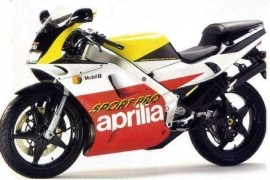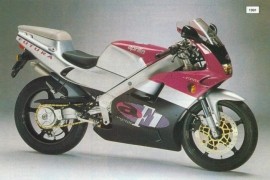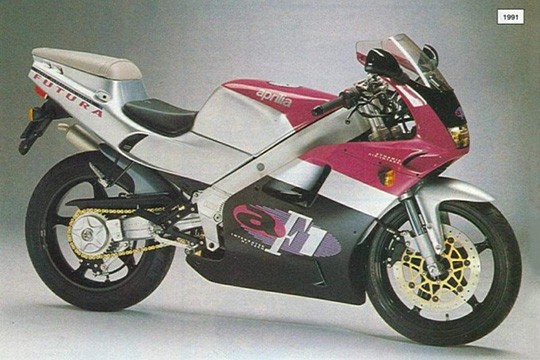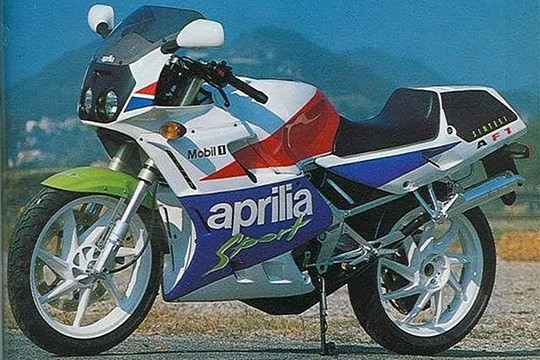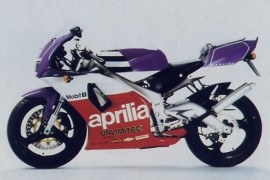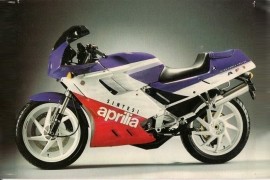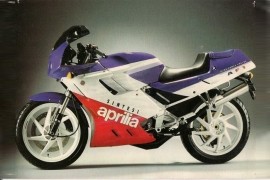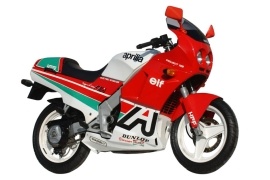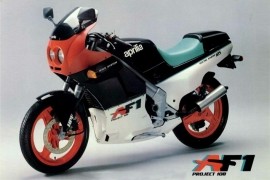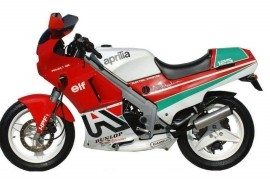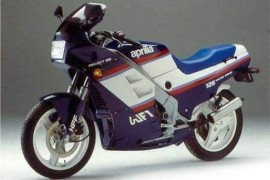APRILIA AF Models/Series Timeline, Specifications & Photos
First production year: 1987
In 1992, the Italian motorcycle manufacturer launched the Aprilia AF1 125 Sport Pro, the last AF1 motorcycle in the series that featured several modifications and improvements, enhancing its overall capabilities.
The 1992 Sport Pro motorcycle came with a slightly different tail section, small air intakes, and a new front fender. In the end, the bike was replaced by the RS 125, a motorcycle fitted with the new Rotax engine, more reliable and powerful.
The bike had standard fittings such as a full fairing with a rectangular headlight, a medium-sized windscreen, a two-piece dual seat, a single exhaust system with a silencer mounted high on the left side, a single-sided swingarm, and five-spoke aluminum wheels.
The bike’s suspension system comprised a 38 mm upside-down telescopic fork with 120 mm of travel on the front and an adjustable monoshock on the rear with 120 mm of travel, offering optimum suspension performance and handling.
The bike rolled on 17-inch wheels controlled by a 320 mm brake disc mounted on the front and handled by a four-piston caliper. The rear wheel packed a 240 mm brake disc engaged by a dual-piston caliper.
In the power department, the 1992 Aprilia AF1 125 Sport Pro took its nerves from a 124cc two-stroke single-cylinder liquid-cooled engine that delivered 33 hp at 11,000 rpm and 20 Nm (15 lb-ft) torque at 10,000 rpm.
The Aprilia AF1 was a sports motorcycle produced by Aprilia in 1986 and continued production until 1993. The bike was available in 50cc and 125cc and spread around several series.
In 1991, the Italian motorcycle manufacturer launched the Aprilia AF1 Futura, a sports machine in its second year of production, packing the same technical, visual, and performance specifications as the previous model without significant modifications.
In the visual department, the bike had standard features such as a full fairing with a rectangular headlight, a small windscreen, a two-piece dual seat, a high-mounted single exhaust system with a muffler on the left side, a single-sided swingarm, and five-spoke aluminum wheels.
The 1991 Aprilia AF1 Futura had its soul brought to life by a 124cc two-stroke liquid-cooled single-cylinder engine with a 28 mm Dell'Orto carburetor in charge, boasting 30 hp at 8,800 rpm and 20 Nm (15 lb-ft) torque at 10,000 rpm.
As for suspension, the bike was fitted with a 38 mm upside-down telescopic fork with 120 mm of travel on the front and a single shock absorber with 120 mm of travel on the rear, offering optimum handling capabilities.
Braking-wise, the motorcycle rolled on 17-inch five-spoke aluminum wheels fitted with a 320 mm brake disc tied to a four-piston caliper on the front and a 240 mm disc squeezed by a dual-piston caliper on the rear.
The Aprilia AF1 was a sports motorcycle manufactured by Aprilia in 1986 and continued production until 1993. The bike was available in 50cc and 125cc and spread around several series.
In 1990, the Italian motorcycle manufacturer launched the Aprilia AF1 Futura, a sports motorcycle that featured the same characteristics as the Sintesi version with rounder fairings and the return of the rectangular headlight.
The bike's aesthetic department was characterized by standard fittings such as a full fairing with a rectangular headlight, a small windscreen, a two-piece dual seat, a high-mounted single exhaust system with a muffler on the left side, a single-sided swingarm, and five-spoke aluminum wheels.
The bike's suspension system comprised a 38 mm upside-down telescopic fork with 120 mm of travel on the front and a single shock absorber with 120 mm of travel on the rear.
The bike's 17-inch five-spoke aluminum wheels were fitted with a 320 mm brake disc tied to a four-piston caliper on the front and a 240 mm disc squeezed by a dual-piston caliper on the rear.
As for the power figures, the 1990 Aprilia 125 AF1 Futura had its heartbeat set by a 124cc two-stroke liquid-cooled single-cylinder engine with a 28 mm Dell'Orto carburetor feeding the piston, boasting 30 hp at 8,800 rpm and 20 Nm (15 lb-ft) torque at 10,000 rpm.
The Aprilia AF1 was a sports motorcycle designed, developed, and produced by Aprilia between 1986 and 1993. The bike was available in two versions, 50cc and 125cc. The AF1 125 was manufactured in various series with numerous modifications.
The Aprilia AF1 125 Sintesi was a motorcycle part of the second series that debuted in 1988. It was slightly different in the visual and mechanics departments, offering a more modern appearance.
In 1990, the Italian motorcycle manufacturer launched the Aprilia AF1 125 Sintesi Sport, a performance-oriented version of the standard machine created to celebrate the success of the Bulega Sport Production Championship in 1989.
The bike's appearance was characterized by standard fittings such as a full fairing with two small round headlights, a windscreen, a single seat with a removable passenger cover, a single exhaust system with a high-mounted silencer on the left side, and aluminum spoke wheels.
The bike's front end was handled by a 38 mm telescopic fork with 120 mm of travel and an Aprilia progressive Sebac monoshock with 120 mm of travel on the rear, offering optimum suspension performance and handling.
As for the power figures, the 1990 Aprilia AF1 125 Sintesi Sport had its heartbeat set by a 124cc two-stroke liquid-cooled single-cylinder engine that delivered an output power of 28 hp with a peak force at 10,500 rpm and 18 Nm (13 lb-ft) torque at 10,000 rpm.
The Aprilia AF1 was a sports bike designed, developed, and produced by Aprilia between 1986 and 1993. The bike was available in two versions, 50cc and 125cc. The AF1 125 was manufactured in various series with numerous modifications.
In 1990, the Italian motorcycle manufacturer launched the Aprilia AF1 Futura Reggiani Replica, a limited edition machine designed as an exact replica of the official House of Noale racing motorcycles used in official competitions.
The bike was built around a steel frame with a 38 mm upside-down telescopic fork on the front, delivering 120 mm of travel, and a single shock absorber with 120 mm wheel travel on the rear, providing optimum suspension performance and handling.
As for the braking performance, the bike's 17-inch wheels were fitted with a 320 mm brake disc on the front squeezed by a four-piston caliper and a 240 mm brake disc on the rear coupled to a dual-piston caliper, offering excellent stopping power.
In the performance department, the 1990 Aprilia AF1 Futura Reggiani Replica was powered by a 124cc two-stroke single-cylinder liquid-cooled engine with a 34 mm Dell'Orto carburetor feeding the piston, boasting 30 hp at 8,800 rpm and 20 Nm (15 lb-ft) torque at 10,000 rpm.
The bike was set in motion by a six-speed transmission that took power from the engine and sent it to the rear end via a final chain drive, pushing the motorcycle to a top speed of 168 kph (105 mph).
The Aprilia AF1 125 Sintesi was a sports motorcycle part of the second series in Aprilia's range that debuted in 1988. The bike was slightly different in mechanics and visual departments, offering a more modern appearance.
In 1989, the Italian motorcycle manufacturer launched the Aprilia AF1 125 SIntesi, a sports motorcycle in its second year of production that featured slight visual modifications, giving it a modern approach.
The bike's fairing featured a new design and still two round headlights with a smaller diameter, a new triple clamp with the AF1 logo in the center, a lower handlebar, racing-style instruments, a new fuel tank, and a different suspension setting.
Visually, the bike had standard features, such as a full fairing with a dual round headlight system, a two-piece dual seat, a single exhaust system mounted high on the left side, and aluminum alloy spoke wheels.
In the performance department, the 1989 Aprilia AF1 125 Sintesi had installed a 124cc two-stroke single-cylinder liquid-cooled engine underneath its fuel tank, delivering 28 hp at 10,500 rpm and 18 Nm (13 lb-ft) torque at 10,000 rpm.
The power generated by the engine was controlled by a six-speed manual transmission that sent it to the rear end by a final chain drive, pushing the bike to a top speed of 169 kph (103 mph).
In 1988, the Italian motorcycle manufacturer launched the Aprilia AF1 125 Sintesi, a motorcycle part of the second series. It was slightly different in the mechanic and visual departments, offering a more modern appearance.
The bike was fitted with standard features, such as a full fairing with a dual headlight system, a medium-sized windscreen, a two-piece dual seat, a single exhaust system with a silencer mounted on the left side, a single-sided swingarm, and new multi-spoke aluminum wheels.
The bike was built around a steel frame with a 38 mm upside-down telescopic fork with 120 mm travel on the front and a Sebac shock absorber with 120 mm of travel on the rear, offering optimum suspension performance.
As for the braking performance, the bike's wheels were fitted with a 320 mm floating brake disc on the front and a 240 mm brake disc on the rear wheel. The discs were squeezed by a four-piston Brembo caliper on the front wheel and a dual-piston caliper on the rear.
In the performance department, the 1988 Aprilia AF1 125 Sintesi had its heartbeat set by a 124cc two-stroke liquid-cooled single-cylinder engine with a 28 mm Dell'Orto carburetor feeding the piston, boasting 28 hp at 10,500 rpm and 18 Nm (13 lb-ft) torque at 10,000 rpm.
The power produced by the engine was handled by a six-speed manual transmission that sent it to the rear end via a final chain drive, pushing the motorcycle to a top speed of 169 kph (103 mph).
In 1998, the Italian motorcycle manufacturer launched the Aprilia AF1 125 Project 108 Replica, as its name suggests, a replica model that celebrated the Grand Prix San Marino race won by Luca Reggiani Misano on August 30, 1987. The bike was sold in December 1987.
Compared to the base model, the Replica version was the same elegant, sporty, and well-managed motorcycle, with a more vibrant color than its sister model. Compared to the standard AF1, the replica version featured several modifications.
Some modifications included a redesigned fairing, a larger tail, a dual round headlight system, a wider windscreen, and a removable passenger seat cover. In addition, the instrument panel, electrical controls, fuel tank, battery, air filter, and other components remained unchanged.
The bike's aesthetic department was characterized by standard fittings such as a full dress with two round headlights, a windscreen, a single seat with a passenger seat cover, a single exhaust system with a silencer mounted on the left side, a single-sided swingarm, and three-spoke aluminum wheels.
In the power department, the 1988 Aprilia AF1 125 Project 108 Replica took its muscles from a small-displacement 125cc two-stroke liquid-cooled single-cylinder engine mounted at its core, delivering an output power of 25 hp with maximum strength at 10,000 rpm and 18 Nm (13 lb-ft) torque at 8,000 rpm.
In 1988, the Italian motorcycle manufacturer launched the Aprilia AF1 125 Project 108 Sport, a fully faired motorcycle best suited for entry-level riders searching for a machine capable of delivering an adrenaline rush with every throttle twist.
The bike was characterized by standard features in the visual department, such as a full fairing with a dual, round headlight system, a windscreen, a single seat with a passenger seat cover, a single-sided swingarm, and three-spoke aluminum wheels.
The bike was built around a steel frame with a four-way anti-dive-adjustable telescopic fork guiding the front wheel and a Sebac shock absorber on the rear, delivering optimum suspension performance and handling.
As for the stopping power, the bike rolled on 16-inch three-spoke aluminum wheels fitted with a 260 mm brake disc on the front and a 240 mm brake disc on the rear wheel, offering optimum braking performance.
As for the power figures, the 1988 Aprilia AF1 125 Project 108 Sport had installed a 124cc two-stroke liquid-cooled single-cylinder engine with a 28 mm Dell'Orto carburetor in charge, boasting 25 hp with maximum strength at 10,000 rpm and 18 Nm 913 lb-ft) torque at 8,000 rpm.
The power generated by the engine was sent to a six-speed gearbox with a wet multi-disc manual clutch and redirected to the rear end via a final chain drive, launching the motorcycle to 157 kph (97 mph).
In 1987, at the Milan Show, the Italian motorcycle manufacturer presented the Aprilia AF1 125 Project 108 Replica, a special edition motorcycle that celebrated the Grand Prix San Marino race won by Luca Reggiani Misano on August 30, 1987. The bike was sold in December 1987.
The AF1 Replica was basically the same elegant, sporty, and well-managed bike as its AF1 sister but was characterized by a more vibrant color than its sister model. Compared to the standard AF1, the replica version featured several modifications.
The AF1 Replica came with a redesigned fairing, a larger tail, a dual round headlight system, a wider windscreen, and a removable passenger seat cover. In addition, the instrument panel, electrical controls, fuel tank, battery, air filter, and other components remained unchanged.
As for the standard features, the bike came dressed in a full fairing, a single seat with a pillion seat cover, a single exhaust system with a muffler on the left side, a single-sided swingarm, and three-spoke lightweight aluminum wheels.
As for power, the 1987 Aprilia AF1 125 Project 108 Replica had installed a 124cc two-stroke single-cylinder liquid-cooled engine underneath its clothes, boasting 29 hp with a peak force at 10,500 rpm and 18 Nm (13 lb-ft) torque at 10,000 rpm.
A six-speed manual transmission controlled by a wet multi-disc clutch handled the bike's power, sending it to the rear wheel via a final chain drive, launching the motorcycle to 169 kph (105 mph).
The Aprilia AF1 was a sports motorcycle designed, developed, and produced by Aprilia between 1986 and 1993. The bike was available in two versions, 50cc and 125cc. The AF1 125 was manufactured in various series with numerous modifications.
The Aprilia AF1 125, also known as the AF1 125 Project 108, debuted in 1987, packing a 124cc single-cylinder Rotax V 127 liquid-cooled engine coupled to a six-speed transmission that developed 27 hp, launching the bike to 158 kph (98 mph).
In the visual department, the bike had standard features, such as full fairing with a rectangular headlight, a small windscreen, a one-piece dual seat with passenger grab handles, a single exhaust system with a silencer mounted on the left side, a single-sided swingarm, and three-spoke aluminum wheels.
The front end was handled by a four-way anti-dive-adjustable telescopic fork, while the rear end was controlled by a Sebac shock absorber, offering optimum suspension performance and handling.
The bike glided on 16-inch three-spoke aluminum wheels fitted with a 260 mm brake disc on the front and a 240 mm brake disc on the rear, delivering optimum braking performance.
At its core, the 1987 Aprilia AF1 125 Project had installed a small-displacement 123cc two-stroke liquid-cooled single-cylinder engine managed by a Dell'Orto carburetor, delivering 25 hp at 10,000 rpm and 18 Nm (13 lb-ft) torque at 8,000 rpm.
